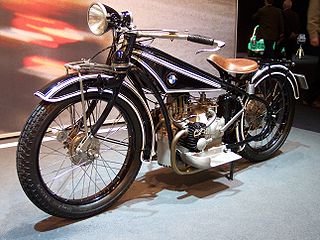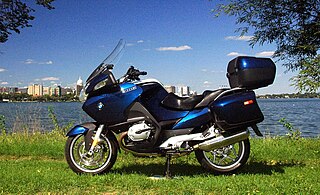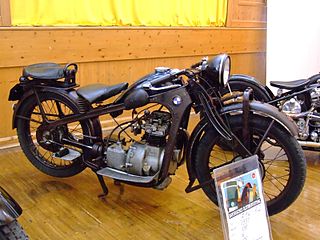
A flat-twin engine is a two-cylinder internal combustion engine with the cylinders on opposite sides of the crankshaft. The most common type of flat-twin engine is the boxer-twin engine, where both pistons move inwards and outwards at the same time.

BMW's motorcycle history began in 1921 when the company commenced manufacturing engines for other companies. BMW's own motorcycles—sold under the BMW Motorrad brand—began in 1923 with the BMW R 32, which was powered by a flat-twin engine. Production of motorcycles with flat-twin engines continues to this day, however BMW has also produced many models with other types of engines.

In automotive engineering a multi-valve or multivalve engine is one where each cylinder has more than two valves. A multi-valve engine has better breathing and may be able to operate at higher revolutions per minute (RPM) than a two-valve engine, delivering more power.

The Honda CX series motorcycles, including the GL500 and GL650 Silver Wing variants, were developed and released by Honda in the late 1970s, with production ending in most markets by the mid 1980s. The design included innovative features and technologies that were uncommon or unused at the time such as liquid cooling, electric-only starting, low-maintenance shaft drive, modular wheels, and dual CV-type carburetors that were tuned for reduced emissions. The electronic ignition system was separate from the rest of the electrical system, but the motorcycle could only be started via the start button.

A motorcycle engine is an engine that powers a motorcycle. Motorcycle engines are typically two-stroke or four-stroke internal combustion engines, but other engine types, such as Wankels and electric motors, have been used.

The BMW GS series of dual-sport BMW motorcycles have been produced from 1980, when the R80G/S was launched, to the present day. The GS originally stood for Gentleman's Scrambler, but was later renamed to Gelände/Straße. GS motorcycles can be distinguished from other BMW models by their longer travel suspension, an upright riding position, and larger front wheels – typically 19 to 21 inch. In May 2009, the 500,000th GS was produced, an R1200GS model.

The BMW R90S is a 900cc sport motorcycle produced by BMW from 1973 to 1976. BMW commissioned designer Hans Muth to oversee the R90S, which became the flagship of the boxer engined "/6" range. Sporting distinctive two-tone paintwork, a bikini fairing and a new tail, the R90S was intended to shrug off the enduring image of BMW bikes as staid and utilitarian.

The BMW R1200RT is a touring or sport touring motorcycle that was manufactured from 2005 to 2019 by BMW Motorrad to replace the R1150RT model. It features a 1,170 cc (71 cu in) flat-twin engine with a six-speed gearbox and shaft drive.

Douglas was a British motorcycle manufacturer from 1907 to 1957 based in Kingswood, Bristol, owned by the Douglas family, and especially known for its horizontally opposed twin cylinder engined bikes and as manufacturers of speedway machines. The company also built a range of cars between 1913 and 1922.

The R60 and R60/2 are 600 cc boxer-twin that were manufactured from 1956 to 1969 in Munich, Germany, by BMW.

The BMW R1100GS is a dual-sport motorcycle that was launched in 1993, and manufactured from 1994 to 1999 by BMW Motorrad in Berlin, Germany. The bike has a 1,085 cc (66.2 cu in) flat-twin (boxer) engine, first seen in the R1100RS which was launched the year before in 1992, and was the first member of the GS family to use an air- and oil-cooled engine rather than the earlier air-cooled airhead engines which had been used on BMW motorcycles since the R32 in 1923.

Victoria was a bicycle manufacturer in Nürnberg, Germany that made motorcycles from about 1901 until 1966. It should not be confused with a lesser-known, unrelated Victoria Motorcycle Company in Glasgow, Scotland that made motorcycles between 1902 and 1928.
BMW Motorrad is the motorcycle brand and division of German automotive manufacturer, BMW. It has produced motorcycles since 1923, and achieved record sales for the fifth year in succession in 2015. With a total of 136,963 vehicles sold in 2015, BMW registered a growth of 10.9% in sales in comparison with 2014. In May 2011, the 2,000,000th motorcycle produced by BMW Motorrad was an R1200GS.

The BMW R65 is a light touring motorcycle introduced by BMW in 1978 to add a mid-size motorcycle to its product line. The original R65, contrary to the views of some commentators, has the same sized frame as the larger R series motorcycles. The R65 does however have a shorter swingarm than its siblings and therefore a shorter bolt-on rear sub-frame; this, along with the shorter front forks and 18" front wheel, gives the illusion that the R65 frame is smaller. The initial model R65 was manufactured until 1984. In 1985 the R65’s engine was put into the same frame and suspension as the R80 which featured a single rear shock absorber (mono-shock). Additionally, between 1981 and 1984, the R65LS was manufactured. This R65 variant has a small triangular fairing that was designed by Hans Muth.

The BMW R 80 G/S is a motorcycle that was manufactured in Berlin, Germany, by BMW Motorrad from 1980 to 1987. Production totalled 21,864 bikes. It was the first in the BMW GS family of specialised dual-sport bikes, of which over 500,000 have been produced, and is often considered the world's first "Adventure Bike" able to be equally capable on and off-road. The designation G/S stands for the German words Gelände/Straße, which mean offroad/road – highlighting the bike's dual sport design.

The BMW R2 was a 198 cc overhead valve single-cylinder motorcycle produced by BMW between 1931 and 1936, the smallest motorcycle ever to enter series production with the firm. Despite its much smaller design and engine capacity, the R2 retained many features of the larger boxer twin motorcycles in the range, such as cardan shaft drive and a pressed-steel duplex frame. The R2 was the smallest in the range of singles produced during the 1930s by BMW, with its big brothers being the 305 cc R3 and the 400 cc R4.

The BMW R1100S is a sports motorcycle that was manufactured by BMW Motorrad between 1998 and 2005. Introduced some 25 years after the R90S, the company's first sports bike, the R1100S was the first BMW bike having clip-on handlebars, rearset footrests and a removable cowl to cover the pillion seat. Producing nearly 100 hp, it has been described as a "sporty sports-tourer".

BMW R100, with variant models designated by T, S, CS, RS, RS Classic, RT, RT Classic, TIC, TC, R and GS is a BMW motorcycle series, using a two-cylinder four-stroke boxer engine of 980 cc capacity. Model production began in 1976, with a premature shutdown and subsequent restart in 1985, and final completion of the series in 1996.
The Ferrari flat-12 engine family is a series of flat-12 DOHC petrol engines produced by Ferrari from 1964 to 1996. The first racing Ferrari flat-12, the Mauro Forghieri-designed Tipo 207, was introduced in the Ferrari 1512 F1 car in 1964. Later flat-12 racing engines were used in Ferrari Formula One and sports racing cars from 1968 until 1980, including the 212 E Montagna, 312 B series, 312 PB and 312 T series. The roadgoing flat-12 engines were introduced with the 365 GT4 BB and were produced in various versions until the end of F512M production in 1996.

Flathead motorcycles are a type of bike that was a standard for pre-war motorcycles, in particular US V-twins such as Harley-Davidson and Indian, some British singles, BMW flat twins and Russian copies thereof.



















